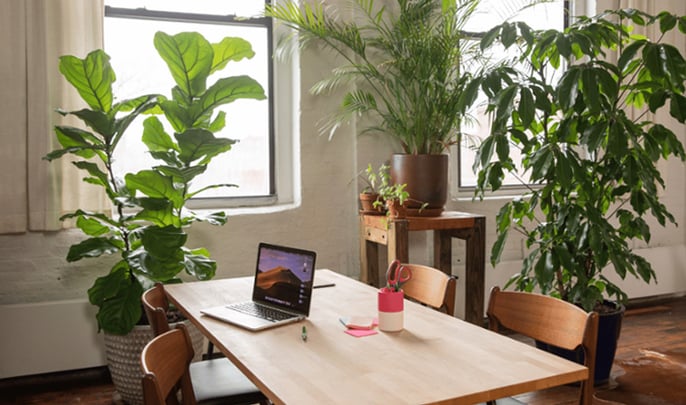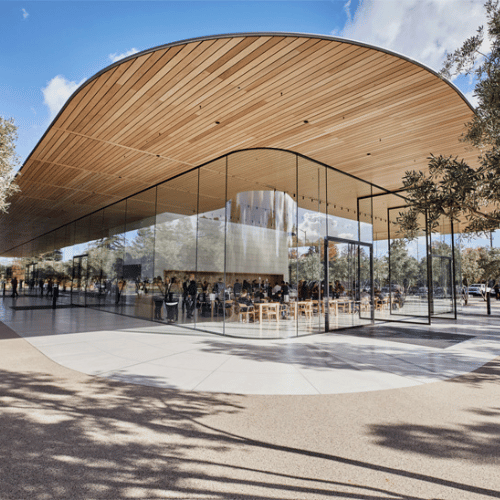City planning and the modern workspace have limited our exposure to the outdoors. Because of this, we are finding new ways to bring nature indoors so we can experience a portion of its benefits and beauty.
Interior designers and space planners have begun to strategically incorporate elements of nature using biophilic design such as: maintaining views of gardens and other green spaces and using biodegradable materials.
The biophilic design movement aims to add a bit of green to the workplace. Let’s talk about biophilic design and its usefulness in the office.
What is Biophilic design?
Biophilic Design is an exciting architectural concept. It focuses on human attraction to nature and the global natural processes. Biophilia suggests that we all have a genetic connection to the natural world, which has progressed through hundreds of years.
For an office space to be considered biophilic, it must be naturalistic, organic, and have a semblance of nature. Design is not biophilic if it doesn't emphasize aspects of the natural world that improve human productivity and health.
Here are some of the characteristics of biophilic design:
-
- Environmental features: This includes basic things like earthy colors, sunlight, plants, and images of nature.
- Nature shapes: The re-creation of natural features like rock shelves, waterways, and arches are notable examples.
- Natural lighting: Light helps merge the inside and outside using warmth and different shapes.
- Plants: The focus can be on real plants, visuals, or the hues of the plants. Here, establishing a connection between the office and the natural components it uses is the goal.
- The human-nature relationship: It's about restoring a relationship that has existed for thousands of years. The office will focus on themes like curiosity, creativity, affection, exploration, discovery, and awe.
A quality biophilic design considers the environment's purity, the air we breathe, and how the sun feels on our skin.
Benefits of Biophilic Design
Here are some of the benefits of biophilic design in the workplace:
1. Plants improve air quality
NASA studies showed that plants can reduce levels of some indoor pollutants and help to raise the relative humidity to healthier levels.
2. Increase creativity and productivity
Several studies found that adding just a few houseplants to “lean” workplaces increased productivity by 15% because people who actively interact with their surroundings work more effectively and creatively.
3. Helps relieve stress and improve mental well-being
Studies have shown that having direct access to nature can reduce stress and mental fatigue.
4. Feel happier and healthier
It should come as no surprise that biophilic components increase feelings of happiness. Positive people are more energetic, better at taking care of themselves, and live longer.
5. Attract and retain the best talent
Having an appealing, well-thought-out workspace full of biophilic features demonstrates your company culture.
How to implement Biophilic Design
By incorporating plants, natural light, textures, and other elements of nature, the biophilic interior design brings the outdoors inside, improving our quality of life. To achieve proper implementation of the biophilic feel in your household or office, there must be:
1. Fresh air
Take time to step out of your office space and be outside to help clear your mind. Pay close attention to any bird, rain, or wind noises.
2. Maximize Natural Light
Vitamin D also referred to as the "sunshine vitamin," is essential for controlling calcium, lowering high blood pressure, supporting the health of the muscles, and more. Open your blinds or rearrange your office space so that you can absorb as much Vitamin D as possible.
3. Incorporate Plants
Incorporate greenery in your space. Plants like Peace Lilies, Spider plants, Aloe Vera, and even a cactus are great for beginners. Plants are not just gorgeous, they are also natural air purifiers and mood boosters.

Real-Life Examples
One  of the best examples of biophilic design is widely recognized to be Apple's campus. The donut-shaped building mimics the curved shapes of nature and floods the offices with light from all directions. A brand-new woodland with 9,000 trees also encircles the campus.
of the best examples of biophilic design is widely recognized to be Apple's campus. The donut-shaped building mimics the curved shapes of nature and floods the offices with light from all directions. A brand-new woodland with 9,000 trees also encircles the campus.
Also recognized is the eye-catching Spheres at e-commerce giant Amazon's Seattle offices.
The three transparent greenhouses are packed with various plants, creating a unique workplace.
The entire city-state of Singapore may be the first "biophilic city" in the world. The government has put a lot of effort into incorporating vegetation, water, and wildlife into its buildings, parks, streetscapes, and offices.
Your office green space doesn’t need to be nearly as involved as a biophilic city! The examples given here are a great way to get started, whether you’re adding some starter plants to the office or designing an entirely new workspace.



